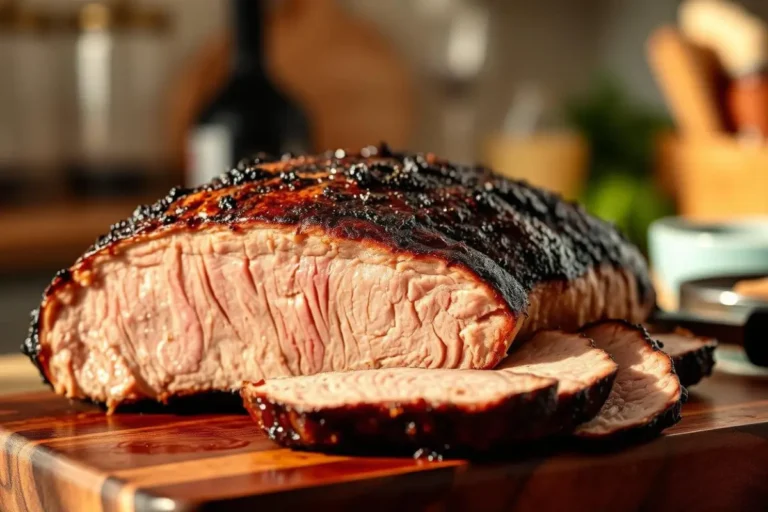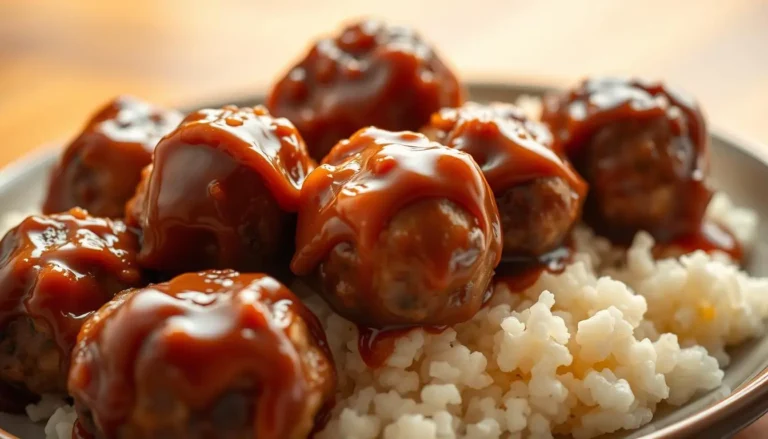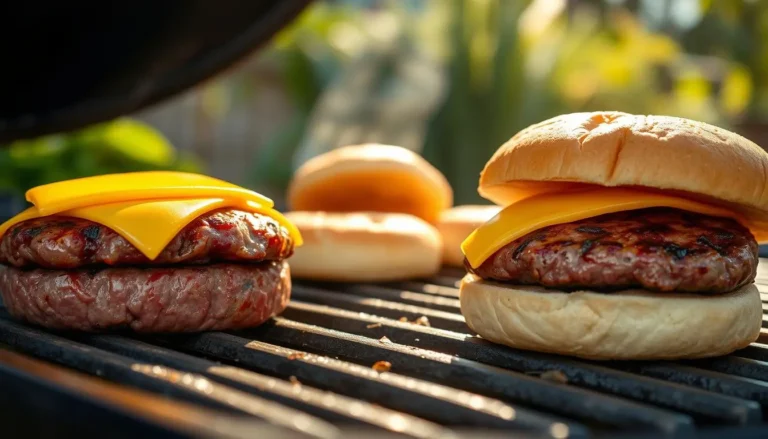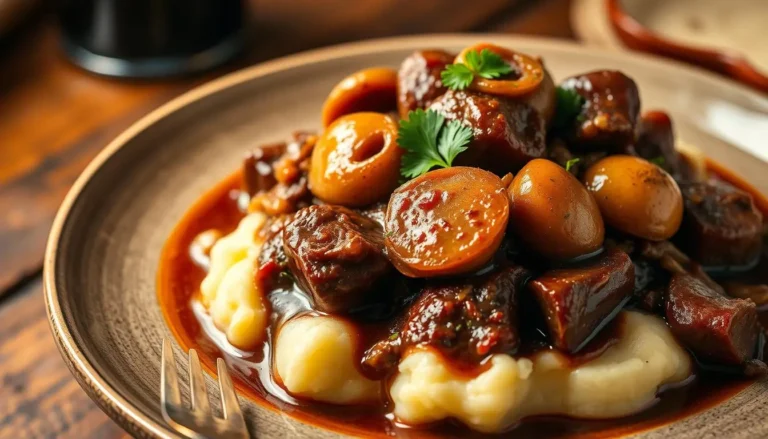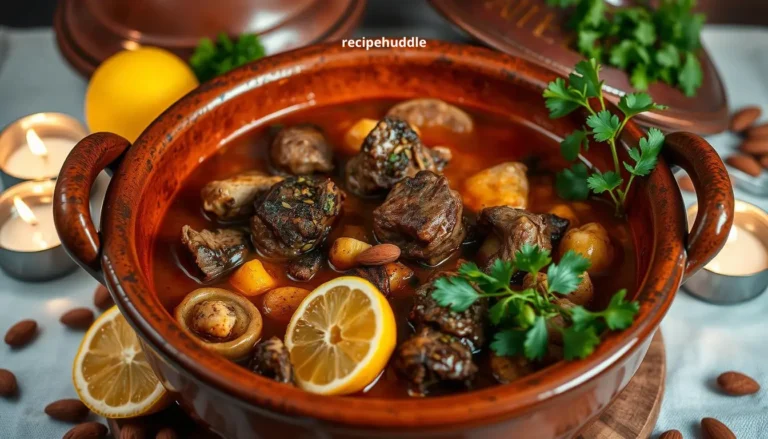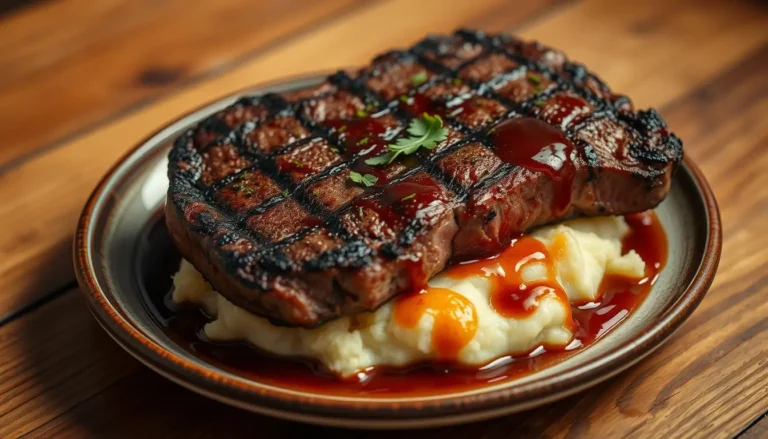How to Make Corned Beef at Home – Easy & Flavorful
How to make corned beef ?
Creating homemade corned beef is a straightforward process that involves curing beef brisket in a salt brine flavored with pickling spices, This traditional method allows you to control the ingredients and the level of saltiness, making it a great option for those looking for a healthier alternative to store-bought corned beef.
You might be surprised at making corned beef from scratch is not only easy but also rewarding, The result is a deliciously tender and flavorful dish perfect for various meals.
Key Takeaways
- Use beef brisket for an authentic corned beef experience.
- A salt brine is essential for curing the beef.
- Pickling spices add a traditional flavor to your corned beef.
- The curing process can take several days.
- Homemade corned beef allows for control over saltiness and ingredients.
The History and Tradition of Corned Beef
As you explore the history of corned beef, you’ll discover its significant Irish-American heritage, Learn more about the origins of corned beef here, Corned beef has become a staple in many cuisines, particularly around St. Patrick’s Day celebrations.
Corned beef’s history is deeply intertwined with the Irish diaspora, especially in the United States, where it became a substitute for the traditional Irish bacon.
Irish-American Connections
The connection between corned beef and Irish-American culture is profound, In the mid-19th century, Irish immigrants in the U.S, adopted corned beef as a replacement for bacon, which was a staple in Ireland, This shift was largely due to the availability and affordability of beef in America, as opposed to pork in Ireland.
Why It’s Called “Corned” Beef
The term “corned beef” originates from the use of “corns” of salt to cure the beef, This preservation method involved covering the meat in coarse salt grains, known as “corns,” to draw out moisture and preserve the meat.
| Aspect | Description | Significance |
| Origin | Corned beef originated from Irish preservation techniques. | Reflects cultural heritage. |
| Preservation Method | Use of “corns” of salt to cure beef. | Allowed for longer storage. |
| Cultural Significance | Adopted by Irish-Americans as a staple. | Symbolizes Irish-American culture. |
What You Need to Know Before Getting Started
To ensure a successful corned beef-making experience, it’s essential to understand the basics, Making corned beef at home requires some knowledge of the ingredients and equipment needed.
Selecting the Right Cut of Beef
The most common cut used for corned beef is the brisket, When selecting a brisket, look for a flat cut or a point cut, as these are the most suitable for corned beef, The flat cut is leaner and easier to slice, while the point cut has more marbling, making it more tender, You can choose either or a combination of both, depending on your preference.
Essential Equipment for Homemade Corned Beef
To make corned beef at home, you’ll need a few essential pieces of equipment, A large container is necessary for brining the beef, and a pot is required for cooking it, You may also want to consider using a slow cooker or Instant Pot for added convenience, Additionally, a sharp knife and cutting board will come in handy for slicing and preparing the meat.
By understanding the basics of corned beef ingredients and equipment, you’ll be well on your way to creating delicious homemade corned beef using the best corned beef method, With easy corned beef at home, you can enjoy this classic dish whenever you want.
Ingredients for Perfect Homemade Corned Beef
The ingredients you choose will significantly impact the flavor and texture of your homemade corned beef, To achieve the best results, it’s crucial to understand the role of each component in the recipe.
The Meat: Brisket Basics
For homemade corned beef, you’ll need a beef brisket, which is typically available at most supermarkets or butcher shops, The brisket is a tougher cut of meat that becomes tender and flavorful after the brining process, When selecting a brisket, look for one that is well-trimmed and has a good balance of fat and lean meat.
Brining Spices and Seasonings
The brining mixture is where you can get creative with your corned beef, Essential spices and seasonings include kosher salt, brown sugar, and pickling spices, The kosher salt helps to preserve the meat, while the brown sugar adds a touch of sweetness, Pickling spices, which typically include a blend of spices like mustard seeds, coriander, and cloves, contribute to the characteristic flavor of corned beef.
Optional Ingredients and Variations
Depending on your preferences, you can customize your corned beef recipe with optional ingredients, Pink curing salt is one such ingredient that helps to achieve the traditional pink color associated with corned beef, You can also experiment with additional spices or flavorings, such as garlic, bay leaves, or mustard seeds, to create a unique taste profile.
Creating the Perfect Brine Solution
A good corned beef recipe starts with a good brine, which is surprisingly easy to make at home, The brine is the foundation of the corned beef’s flavor and texture, making it a crucial step in the process.
The basic components of a brine include water, kosher salt, brown sugar, and pickling spices, You can adjust the spice blend to suit your taste preferences, and you also have the option to add other ingredients to enhance the flavor.
Basic Brine Recipe
A basic brine recipe is straightforward and requires minimal ingredients, To make a basic brine, you will need:
- 1 gallon of water
- 1 cup of kosher salt
- 1/2 cup of brown sugar
- Pickling spices (such as mustard seeds, coriander seeds, and black peppercorns)
Combine these ingredients in a large pot, bring to a boil, and then let the mixture cool before using it to cure your beef.
Spice Blend Options
The spice blend is where you can get creative with your brine, Consider adding other spices or seasonings to give your corned beef a unique flavor, Some options include:
- Crushed red pepper flakes for a spicy kick
- Fresh or dried herbs like thyme or rosemary
- Garlic or onion for added depth of flavor
Experiment with different combinations to find the perfect flavor for your corned beef.
Pink Curing Salt: Is It Necessary?
Pink curing salt, also known as Prague powder, is a common ingredient in many corned beef recipes, It serves two purposes: it adds a distinctive flavor and helps to preserve the meat, While it’s not strictly necessary, using pink curing salt will give your corned beef the traditional color and flavor associated with this dish.
If you decide to use pink curing salt, be sure to follow the recommended guidelines for the amount to use, as excessive consumption can be harmful.
| Ingredient | Quantity | Purpose |
| Water | 1 gallon | Base of the brine |
| Kosher Salt | 1 cup | Preservation and flavor |
| Brown Sugar | 1/2 cup | Balances the saltiness |
| Pickling Spices | To taste | Adds flavor and aroma |
| Pink Curing Salt | Optional | Traditional color and flavor |
Step-by-Step: How to Make Corned Beef Brine
To create delicious corned beef, you’ll need to prepare the brisket, mix the brine, and let it cure, This process involves several key steps that ensure your corned beef turns out flavorful and tender.
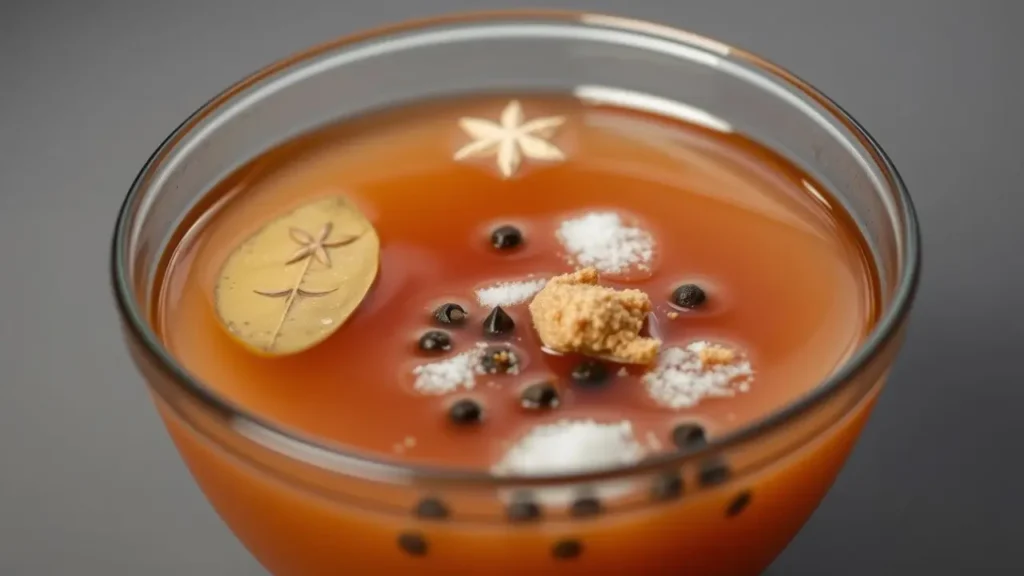
Preparing the Meat
Before you start making the brine, it’s essential to prepare the brisket, Begin by selecting a fresh, high-quality beef brisket, Rinse the brisket under cold water, then pat it dry with paper towels to remove excess moisture, This step helps the brine penetrate the meat more evenly.
Mixing and Applying the Brine
Mixing the brine involves combining the right balance of salt, sugar, and spices, In a large bowl, combine 1 cup of kosher salt, 1/2 cup of brown sugar, and your choice of spices (such as mustard seeds, coriander seeds, and black peppercorns), Add 1 gallon of water to the mixture and stir until the salt and sugar are dissolved, Once the brine is ready, place the brisket in a large container or zip-top bag, and cover it with the brine, making sure the meat is fully submerged.
Proper Storage During Brining
After applying the brine, it’s crucial to store the brisket properly to ensure it cures correctly, Place the container or bag in the refrigerator at a temperature below 40°F (4°C), Keep the brisket refrigerated for the duration of the brining period, turning it occasionally to ensure even curing.
The following table summarizes the key steps and considerations for making corned beef brine:
| Step | Description | Notes |
| Preparing the Meat | Rinse and dry the brisket | Ensures even brine penetration |
| Mixing the Brine | Combine salt, sugar, and spices with water | Adjust spices to taste |
| Applying the Brine | Submerge the brisket in the brine | Use a large container or zip-top bag |
| Storage | Refrigerate at below 40°F (4°C) | Turn the brisket occasionally |
The Brining Timeline: How Long to Cure Your Beef
Curing your beef to perfection requires patience and a clear understanding of the brining timeline, The length of time you brine your beef can significantly impact its final flavor and texture, Whether you’re making corned beef from scratch for a special occasion or just want to ensure it’s done right, understanding the brining process is key.
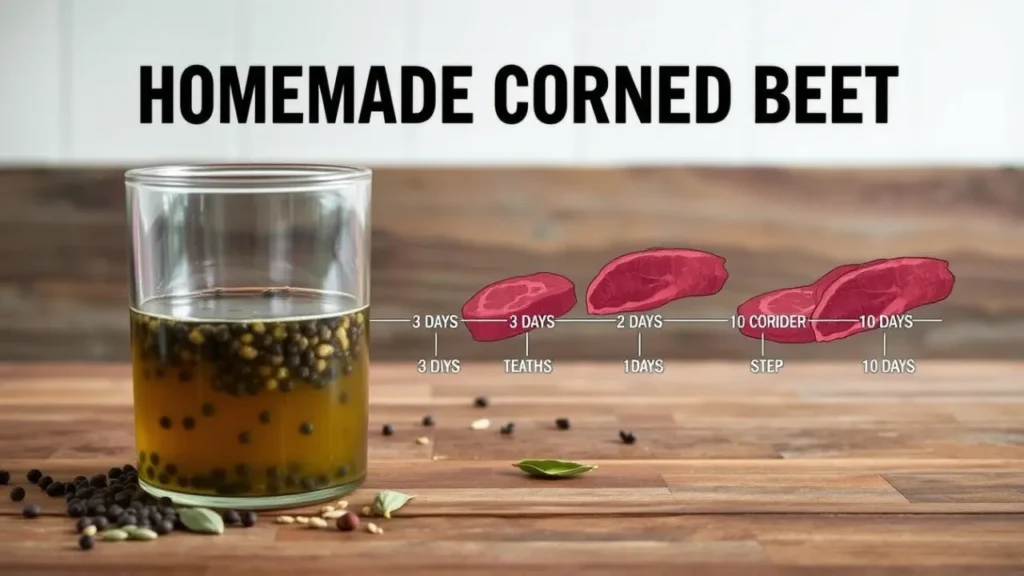
Minimum Brining Requirements
The minimum brining time for homemade corned beef is typically around 5 days, This duration allows the curing salts and spices to penetrate the meat sufficiently, giving it that characteristic corned beef flavor and texture, Brining for less than 5 days may result in an under-cured product that lacks depth in flavor.
Extended Brining for Enhanced Flavor
While 5 days is the minimum, you can extend the brining time up to 10 days for even more flavorful results, Extended brining allows the meat to absorb more of the spices and curing salts, potentially leading to a more complex and satisfying taste experience, However, it’s crucial to monitor the meat’s condition and ensure it doesn’t become too salty or develop off-flavors.
When making corned beef from scratch, flexibility with the brining time can be beneficial, If you prefer a stronger flavor, you can opt for the longer brining period, but be sure to check on the meat periodically.
Cooking Methods : How to make corned beef ?
Cooking corned beef can be done in various ways, each with its own benefits and guidelines, The choice of method depends on personal preference, equipment, and the desired outcome, In this section, we’ll explore three popular methods for cooking corned beef: traditional stovetop simmering, slow cooker method, and pressure cooker/Instant Pot method.
Traditional Stovetop Simmering
Stovetop simmering is a classic method for cooking corned beef, It involves submerging the corned beef in liquid and simmering it on the stovetop.
Temperature and Timing Guidelines
To achieve tender corned beef, it’s essential to maintain a gentle simmer, The ideal temperature is between 160°F and 180°F. Cooking time will depend on the size and thickness of the corned beef, typically ranging from 2 to 3 hours.
Adding Vegetables
You can add vegetables like cabbage, carrots, and potatoes to the pot during the last 30 minutes of cooking, This will not only add flavor to the corned beef but also create a complete meal.
Slow Cooker Method
The slow cooker method is perfect for those who prefer a hands-off approach, Simply place the corned beef in the slow cooker, add your desired seasonings and liquid, and let it cook.
Set-It-and-Forget-It Approach
One of the benefits of using a slow cooker is the ability to set it and forget it, You can cook the corned beef on low for 8-10 hours or on high for 4-6 hours.
Layering Ingredients Properly
To ensure even cooking, it’s essential to layer the ingredients properly in the slow cooker, Place the corned beef at the bottom, followed by your desired vegetables and seasonings.
Pressure Cooker/Instant Pot Method
For those short on time, the pressure cooker or Instant Pot method is a great option, This method significantly reduces cooking time while maintaining tender results.
Quick Cooking Times
Cooking corned beef in a pressure cooker or Instant Pot can take as little as 90 minutes, However, the exact time will depend on the size and thickness of the corned beef.
Natural vs. Quick Release
When using a pressure cooker or Instant Pot, you can choose between a natural release or quick release, A natural release allows the pressure to release gradually, while a quick release releases the pressure quickly.
How to Tell When Your Corned Beef is Perfectly Cooked
To cook corned beef to perfection, you need to understand the importance of temperature and texture, Cooking corned beef is not just about following a recipe, but also about ensuring that it is cooked to a safe internal temperature and achieves the desired tenderness.
There are two primary methods to determine if your corned beef is perfectly cooked: checking the internal temperature and testing its texture and tenderness.
Temperature Guidelines
The internal temperature of cooked corned beef should reach 190-200°F to ensure food safety and optimal tenderness, Using a meat thermometer is the most accurate way to check the internal temperature, Insert the thermometer into the thickest part of the corned beef, avoiding any fat or bone.
Texture and Tenderness Tests
In addition to checking the internal temperature, you can also test the texture and tenderness of the corned beef, A perfectly cooked corned beef should be tender and easily shreds or slices, You can check the tenderness by inserting a fork or knife into the meat; if it slides in easily, it’s done, Alternatively, you can slice the corned beef against the grain and check if it’s tender and juicy.
Serving Suggestions and Traditional Accompaniments
With your homemade corned beef ready, you can start thinking about the perfect accompaniments to complement its rich flavor. Traditional corned beef is often served with a variety of side dishes that enhance its flavor and texture.
Classic Corned Beef and Cabbage
One of the most classic combinations is corned beef and cabbage, This traditional pairing is a staple of Irish-American cuisine and is often served on special occasions, To prepare, simply slice the cooked corned beef against the grain and serve it with boiled or steamed cabbage, carrots, and sometimes potatoes, This hearty dish is a comforting and satisfying meal that’s perfect for a cold day.
Side Dish Pairings
In addition to cabbage, there are many other side dishes that pair well with corned beef, Some popular options include boiled or roasted potatoes, braised red cabbage, and sautéed carrots, You can also consider serving your corned beef with other root vegetables like parsnips or turnips, The key is to balance the richness of the corned beef with lighter, fresher flavors that complement its savory taste.
Sauce and Condiment Options
To add an extra layer of flavor to your corned beef, consider serving it with a variety of sauces and condiments, Mustard is a classic choice, with options ranging from spicy mustard to more mild, tangy varieties, You can also serve your corned beef with a horseradish sauce or a dollop of sour cream to add a creamy, pungent flavor, Other options include serving it with a side of pickles or pickle relish to add a tangy, salty flavor.
By experimenting with different accompaniments and condiments, you can create a delicious and memorable corned beef recipe that’s sure to please even the pickiest eaters.
Storing and Using Leftover Corned Beef
You’ve made your easy corned beef at home, now let’s talk about storing and using the leftovers, Proper storage and creative reuse can make your homemade corned beef last longer and remain delicious.
Proper Storage Methods
To keep your leftover corned beef fresh, it’s essential to store it correctly, Once cooled, wrap it tightly in plastic wrap or aluminum foil and place it in a covered container or zip-top bag, You can store it in the refrigerator for up to 3-4 days, For longer storage, consider freezing it, When freezing, slice the corned beef against the grain to make it easier to thaw and use only what’s needed.
Tips for Refrigeration: Keep the corned beef away from strong-smelling foods, as it can absorb odors easily.
Delicious Leftover Recipe Ideas
Leftover corned beef is versatile and can be used in a variety of dishes, Here are some ideas to get you started:
- Corned Beef Hash: A classic breakfast dish.
- Reuben Sandwiches: A deli favorite.
Corned Beef Hash
To make corned beef hash, dice the leftover corned beef and mix it with chopped potatoes and onions, Pan-fry until crispy and golden brown, Serve with eggs for a hearty breakfast.
Reuben Sandwiches
For a Reuben sandwich, layer sliced corned beef, sauerkraut, and Swiss cheese between slices of rye bread, Grill until the cheese is melted and the bread is toasted, Add Thousand Island dressing for extra flavor.
Conclusion
Now that you’ve learned the steps to make corned beef from scratch, it’s time to give it a try, With this guide, you can create a delicious, homemade corned beef that’s tailored to your taste preferences, From selecting the right cut of beef to cooking it to perfection, you’ve got the tools you need to succeed.
By following these steps, you’ll not only be able to enjoy a mouth-watering corned beef dish but also develop a new skill that will impress your family and friends, So, don’t be afraid to experiment with different spices and seasonings to create your unique flavor profile, With practice, you’ll become a pro at making corned beef at home.
Whether you’re a seasoned cook or a beginner, making corned beef from scratch is a fun and rewarding experience, So, get started today and discover the joy of cooking this classic dish.
FAQ
What is the best cut of beef to use for making corned beef?
The best cut of beef for making corned beef is the brisket, particularly the flat cut or the point cut, Brisket has the right balance of fat and lean meat, making it tender and flavorful after curing and cooking.
Can I make corned beef without pink curing salt?
While pink curing salt is not strictly necessary, it is highly recommended for making traditional corned beef, Pink curing salt helps to preserve the meat, prevent spoilage, and give corned beef its characteristic flavor and color.
How long does it take to brine corned beef?
The minimum brining time for corned beef is typically around 5 days, but it can be brined for up to 10 days or more for enhanced flavor, The longer you brine, the more flavorful and tender the corned beef will be.
What are the different ways to cook corned beef?
Corned beef can be cooked using various methods, including traditional stovetop simmering, slow cooker, and pressure cooker/Instant Pot, Each method produces a deliciously tender and flavorful result, so you can choose the one that suits your preference and schedule.
How do I know when my corned beef is cooked to perfection?
To check if your corned beef is cooked, use a meat thermometer to ensure it has reached an internal temperature of at least 160°F (71°C). You can also test its tenderness by inserting a fork or knife; if it slides in easily, it’s done.
Can I store leftover corned beef, and how?
Yes, you can store leftover corned beef, To keep it fresh, wrap it tightly in plastic wrap or aluminum foil and refrigerate or freeze it, Leftover corned beef can be used in a variety of dishes, such as sandwiches, salads, and hash.
What are some traditional accompaniments to serve with corned beef?
Classic accompaniments to corned beef include boiled or steamed cabbage, boiled potatoes, carrots, and sometimes mustard or horseradish sauce, You can also serve it with other side dishes like rye bread or pickles.
Can I make corned beef from scratch without a large container for brining?
Yes, you can still make corned beef from scratch even without a large container, Consider using a large ziplock bag or a smaller container with a weight to keep the meat submerged in the brine, or look for alternative brining methods.


